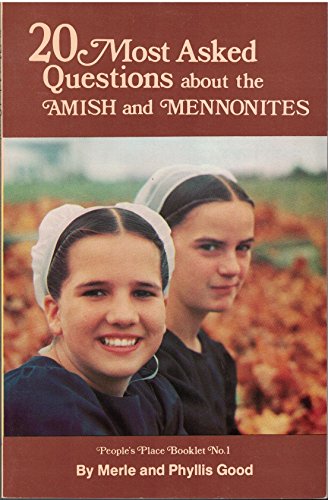20 Most Asked Questions About the Amish and Mennonites (People's Place) - Softcover

"synopsis" may belong to another edition of this title.
Merle Good is an author, publisher and playwright from Lancaster, Pennsylvania. He has written numerous books and articles, including Op-Ed essays for The New York Times and The Washington Post. He and his wife Phyllis oversee a series of projects in publishing and the arts. They are the parents of two adult daughters.
Chapter 1—What is the difference between the Amish and the Mennonites?
Anyone who tries to answer this question in one simple sentence is either naive or purposefully unkind.
Which of us would want our lives summed up in one sweeping statement? Yet many of us demand this of other people's lives.
The danger of generalizations
As authors, we must declare ourselves on the very first pages of this book. It is impossible to interpret the lives of a people -- any people -- in one or two quick sentences. It seems a violent act.
When a people become the object of curiosity and tourism as the Amish and the Mennonites have in various parts of North America, a lot of shallow, fast-buck, one-line interpretations appear.
There are dozens of varieties among the Amish and Mennonite groups around the world. Words like "always" and "never" seldom apply in describing the whole Mennonite-Amish family. On most of the topics we will cover in this book, there are many shades of belief and practice among our various groups.
Our purpose is to qualify generalizations while being as specific as possible. This can be frustrating. We will use the words "most" and "some" and "seldom" a great deal. Many readers will wish we would make more sweeping observations. But one-line generalizations create human zoos. People become spectacles.
The various Amish and Mennonite groups of Lancaster County, Pennsylvania, are the central focus of our study. We will attempt throughout the book, however, to include information about the worldwide peoplehood.
In general
We will risk several generalizations at this point:
1. Most Mennonite and Amish groups have common historical roots. Their beginnings (1525) date from a group of persecuted radical Christians nicknamed "Anabaptists" at the time of the Protestant Reformation in Europe. They sought a return to the simplicity of faith and practice as seen in the early Christian church in the Bible. The Amish division took place a century and a half later in 1693. This history will be discussed in detail in the next chapter.
2. All Amish and Mennonite groups are Christian fellowships. Most of them stress that belief must result in practice. "By their fruits you shall know them" (Matthew 7:20). Therefore, emphases on lifestyle and peace have distinguished most of the groups throughout the centuries. More on this in Chapter 3.
3. The differences among the various Amish and Mennonite groups through the years have almost always been ones of practice rather than basic Christian doctrine. This is not to minimize the differences, because they are real. But even today a survey of the whole family would show few differences on the Christian teaching of creation and redemption and a great many on how one should dress and how a congregation should make decisions.
More specifically
Amish groups tend to be more cautious on technology and involvement with the larger world than most Mennonites. Most Old Order Amish, for instance, drive horse-drawn carriages, dress "plain," refrain from the use of electricity, emphasize occupations close to the farm and the home, and forbid higher education. Many Mennonites, on the other hand, are considerably more acculturated. They embrace education and technology as opportunities, accept reluctantly the stress which modern life places on marriage and the family, and encourage an enlargement of the fellowship through worldwide missionary activities.
But this is very general. Thousands of Mennonites drive horses and buggies, avoid higher education, and are cautious on missions. And some Amish groups drive cars and encourage high school and mission work.
We find it more helpful for purposes of discussion to collect the many groups into two main categories: 1) those who take their cues for decision-making primarily from their faith fellowship, whom we shall refer to as "Old Order" (this may include many small urban groups who are "Old Order" in their dynamic); and 2) those who are more influenced in their primary decision-making by what the larger society thinks than by what their faith fellowship believes, whom we shall refer to as "modern."
These categories of "Old Order" and "modern" are much more helpful than "Mennonite" and "Amish" in describing the total family. In many cases, the Old Order Amish, the Old Order Mennonites, the Old Colony Mennonites, the Hutterites, and an inner-city Mennonite house church may share more in common than they do with more rapidly acculturating Mennonite and Amish groups.
In summary
One last comment. There are more similarities among the Mennonite-Amish fellowship worldwide than there are dissimilarities.
Obviously there are many differences, especially among the groups at the far edges of the spectrum. But there remain many unifying themes among the various Mennonite and Amish groups worldwide, even though the groups are organizationally independent.
The remainder of this book will explore both the differences and the likenesses of our peoples.
"About this title" may belong to another edition of this title.
- PublisherPeople's Place
- Publication date1979
- ISBN 10 0934672008
- ISBN 13 9780934672009
- BindingPaperback
- Number of pages96
- Rating
Buy New
Learn more about this copy
Shipping:
US$ 4.13
Within U.S.A.
Top Search Results from the AbeBooks Marketplace
20 MOST ASKED QUESTIONS ABOUT TH
Book Description Condition: New. New. In shrink wrap. Looks like an interesting title! 0.3. Seller Inventory # Q-0934672008

